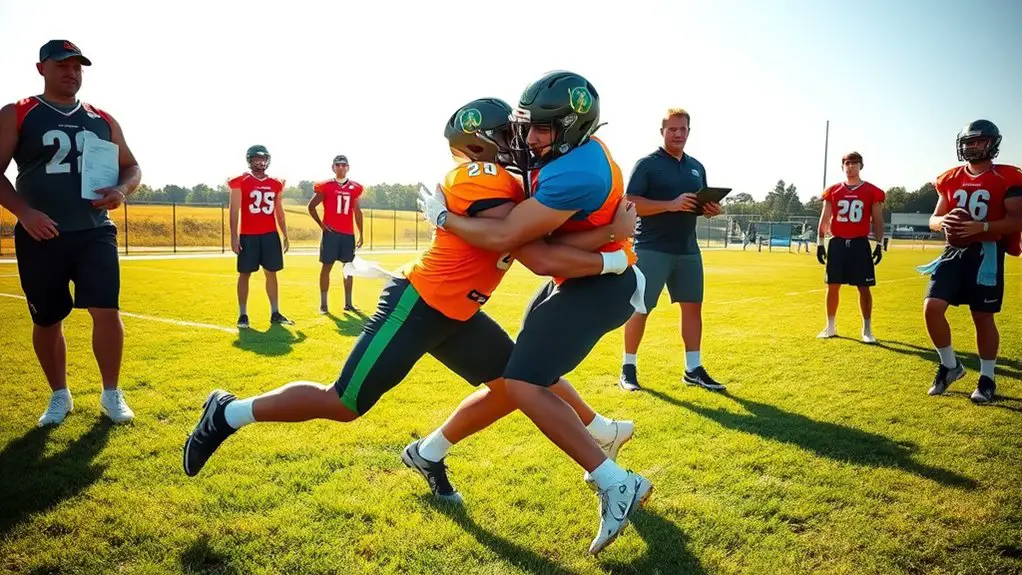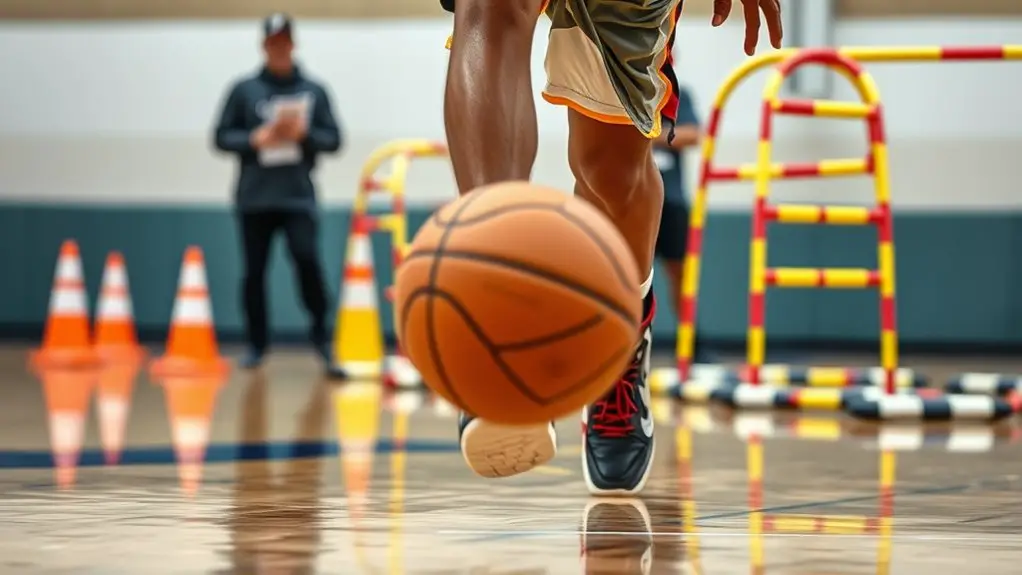To improve your tackling skills, focus on mastering proper technique. Start with basic drills like the "Hawk Tackle" and "Tackle Bag Drill" to build your foundation. As you progress, challenge yourself with advanced drills like the "Angle Pursuit Drill" and "One-on-One Tackle Simulation." Don't forget agility and speed drills, like ladder and cone drills, to enhance your performance. Stick around to uncover more tips and techniques that could elevate your tackling game even further.
The Importance of Proper Tackling Technique
Although many players focus on speed and strength, mastering proper tackling technique is vital for both safety and effectiveness on the field. You'll want to embrace tackling fundamentals that guarantee you can take down opponents without risking injury to yourself or them. Understanding body positioning, timing, and leverage is essential for executing successful tackles.
Technique refinement is where you'll find the freedom to express your skills while maintaining control. When you tackle correctly, you're not just a player; you become a force that respects the game and your teammates. It's about finding that balance between aggression and discipline.
Investing time in developing your tackling technique gives you the confidence to engage effectively, leading to better performance and fewer injuries. So, don't overlook the importance of proper tackling—embrace it, refine it, and let it elevate your game to new heights.
Basic Tackling Drills for Beginners
Having a solid tackling technique sets the foundation for effective drills that can enhance your skills. As a beginner, it's important to focus on tackling fundamentals to build confidence and safety on the field. Start with the "Hawk Tackle," where you lower your body, keep your head up, and drive through the opponent's midsection. This beginner technique helps you learn to wrap up and secure the tackle effectively.
Next, try the "Tackle Bag Drill." Use a tackle bag to practice your approach, ensuring you maintain proper form while driving through the bag. This drill reinforces body positioning and footwork without the pressure of a live opponent.
Lastly, incorporate "Shadow Tackling," where you simulate tackles with a partner, emphasizing technique without physical contact. These basic tackling drills will empower you to develop your skills while enjoying the freedom of the game.
Advanced Tackling Drills for Experienced Players
As you progress in your football journey, refining your tackling skills becomes essential for both performance and safety. Advanced tackling drills focus on perfecting tackle angles and improving contact balance, allowing you to dominate the field. Here are four effective drills to elevate your game:
- Angle Pursuit Drill: Set up cones to practice various angles, focusing on closing the distance while maintaining balance.
- One-on-One Tackle Simulation: Pair up with a teammate and simulate live scenarios, emphasizing proper form and timing.
- Tackle Bag Drill: Use a tackle bag to enhance your impact and reinforce the importance of driving through with your shoulders.
- Shadow Tackling: Without a partner, visualize an opponent while practicing your tackle angles and footwork, ensuring you're ready for any play.
These drills push your limits and help you tackle with confidence and precision. Embrace the challenge, and own your performance!
Tackling Drills for Enhancing Speed and Agility
While mastering tackling form is essential, enhancing your speed and agility is equally important for effective gameplay. By focusing on speed enhancement and agility training, you can become a more dynamic player on the field. Additionally, incorporating strength training into your routine can significantly improve your overall performance.
Here are some drills to help you elevate your performance:
| Drill | Purpose | Benefits |
|---|---|---|
| Ladder Drills | Agility training | Quick foot movement |
| Cone Drills | Speed enhancement | Rapid directional changes |
| Shuttle Runs | Endurance and speed | Increased stamina |
| Tackle Dummies | Practice tackling form | Realistic tackling experience |
Incorporating these drills into your routine will give you the freedom to move fluidly, allowing you to tackle opponents more effectively. Embrace the challenge and watch your skills soar; every bit of speed and agility counts in your pursuit of greatness!
Safety Tips for Effective Tackling Practice
To guarantee safe and effective tackling practice, it is crucial to prioritize proper technique over sheer force. By focusing on skillful execution, you can reduce the risk of injury and enhance performance. Here are some important safety tips to keep in mind:
- Use Proper Tackling Equipment: Confirm you're wearing well-fitted helmets and pads that meet safety standards. This gear is your first line of defense.
- Practice in Controlled Environments: Start tackling drills on soft surfaces or with pads to minimize impact.
- Warm Up Before Drills: Always get your muscles ready with dynamic stretches to help prevent injuries. Engaging in proper warm-ups is essential for injury prevention.
- Encourage Communication: Make certain all players know who's involved in the drill to avoid collisions and enhance safety.
Frequently Asked Questions
How Can I Assess My Tackling Progress Over Time?
To assess your tackling progress over time, you'll want to establish clear tackling metrics. Keep track of your successful tackles versus missed ones, and evaluate your technique regularly. You can also film your sessions for a skill evaluation, identifying areas for improvement. By setting specific goals and reviewing your performance, you'll gain the freedom to enhance your skills and track your growth effectively. Remember, consistent reflection is key to your development.
What Equipment Is Necessary for Effective Tackling Drills?
When you think about effective tackling drills, you might believe all you need is determination. But having the right tackling equipment is essential. You'll want tackling dummies, cones, and agility ladders to enhance your skills. Don't forget your safety gear, like helmets and pads, to protect yourself during practice. Investing in quality equipment not only boosts your performance but also gives you the freedom to tackle with confidence, knowing you're well-prepared.
How Often Should Tackling Drills Be Practiced Each Week?
When it comes to tackling frequency, you should aim to practice tackling drills at least two to three times a week. This practice schedule allows you to refine your techniques without overwhelming yourself. Remember, consistency is key, but you also want to keep it enjoyable. Balancing your drills with other skills keeps your training fresh and engaging, giving you the freedom to develop as a player while avoiding burnout.
Can Tackling Drills Be Adapted for Different Age Groups?
Absolutely, tackling drills can be adapted for different age groups. You might worry that younger athletes won't grasp complex techniques, but youth adaptations focus on fundamental skills while prioritizing safety considerations. By simplifying drills, you can guarantee younger players develop confidence and proper form without overwhelming them. It's all about creating a fun, engaging environment that fosters growth, letting kids enjoy the game while learning essential tackling skills tailored to their age and ability.
What Common Mistakes Should I Avoid During Tackling Practice?
When you're practicing tackling techniques, it's essential to avoid common mistakes. Don't underestimate the importance of practice safety; always wear proper gear. Avoid leading with your head, which can lead to injuries. Make certain you're using your arms to wrap up rather than relying solely on your shoulder. Don't forget to communicate with teammates during drills, as clear communication can prevent mishaps. Stay focused, and you'll improve while keeping everyone safe.




